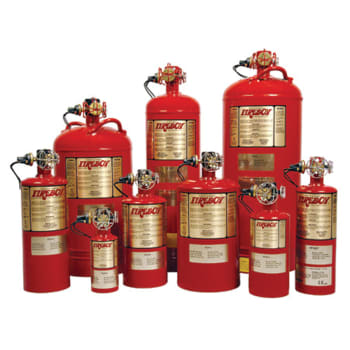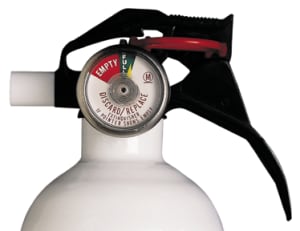Guide to Onboard Fire Extinguishers
 Nothing can get your attention quite like a fire on your boat. Fortunately, there are a variety of fire extinguishers available to help you contain a fire in the first critical minutes. The following guide will help you decide how many and what types of extinguishers to purchase along with some important safety tips on placement and usage.
Nothing can get your attention quite like a fire on your boat. Fortunately, there are a variety of fire extinguishers available to help you contain a fire in the first critical minutes. The following guide will help you decide how many and what types of extinguishers to purchase along with some important safety tips on placement and usage.
Types of Fire Extinguishers:
Fire Extinguishers are classified by letters and numbers according to the class (type) and the size fire they can put out. The letter (A, B or C), indicates the class of fire. The number (1, 3, 5, 10, etc.), is a measure of the capacity of the extinguisher - the larger the number the greater the capacity. You may be surprised to learn that most B-I extinguishers will typically only last approximately 8-12 seconds.
Each class of fire has its own suppression considerations:
- Class A fires involve burning solids such as wood, paper, cloth, rubber and plastics. These are the only fires which can be extinguished with water.
- Class B fires are flammable liquids and gases such as gasoline, diesel, kerosene, alcohol, grease, paints, propane, etc.
- Class C fires involve live electrical circuits and include machinery, appliances, electrical panels, and wiring.
Most marine fire extinguishers are rated B:C (for fighting Class B or C fires), or A:B:C (for fighting all classes of fires). These extinguishers often contain an inert, “dry” chemical extinguishing agent, such as sodium bicarbonate, which physically coats the fuel and prevents access to oxygen, thus extinguishing the fire.
B:C and A:B:C extinguishers may also contain inert gases, such as CO2, FE-241, FM-200, or Halotron. These work by displacing the oxygen-containing air around the fire, thus smothering it. Unlike dry chemicals, these gases leave no residue and make for an easier cleanup. The following table shows what typically comes inside a class B extinguisher.
| Class | Foam (gals) | Dry Chemical (lbs) | CO2 (lbs) |
| B-I (Type B, Size I) | 1.75 | 2 | 4 |
|
B-II (Type B, Size II) |
2.5 | 10 | 15 |
Coast Guard Requirements:
The Coast Guard-approved extinguishers required for boats are hand-portable Class B extinguishers that are classified by capacity as either B-I or B-II and have a specific marine-type mounting bracket (Size III and larger are too big for use on most recreational boats). It is recommended that the extinguishers be mounted in a readily accessible position, but never immediately next to where a fire is most likely, since you may not be able to reach it once the fire has started. As you can see from their choice of Class B extinguishers, the Coast Guard's primary concern is that you be able to fight fuel-related fires - which can't be fought with water.
The table below shows what is required and refers to any boat with an inboard engine, enclosed spaces where vapors could be trapped, or a permanently installed fuel tank. If a U.S. Coast Guard approved fixed fire system is installed for the protection of the engine compartment, the required number of handheld fire extinguishers may be reduced in accordance with the chart.
Minimum number of hand portable fire extinguishers required:
| Vessel Length | No Fixed System | With Approved Fixed Systems |
| Less than 26 ft | 1 B-1 | 0 |
| 26 ft to less than 40 ft | 2 B-1 or 1 B-II | 1 B-I |
| 40 ft to 65 ft | 3 B-I or 1 B-II and 1 B-1 | 2 B-1 or 1 B-II |
Extinguishers which satisfy the Coast Guard requirements must bear a label stating the USCG Type and Size. Note that a fixed fire extinguisher system is equivalent to a Type B-I extinguisher.
Fixed fire extinguishing systems deploy automatically when a fire is detected and are usually found in engine rooms. They are particularly effective in the enclosed space of an engine room where they quickly fill the entire volume with a “clean” agent, thus removing the fire's access to oxygen. While not specifically required by the Coast Guard, they are one of the most valuable fire fighting tools you can install on your boat.
Bear in mind that the above minimum requirements are just that….the minimum. This is especially true considering that most people are inexperienced in the proper use of an extinguisher, that a B-I extinguisher only provides about 10 seconds of fire fighting capability, and that re-ignition is common. Prudent mariners will install additional and/or larger extinguishers for an extra margin of safety. You should also consider spending the few extra dollars for a tri-class (A:B:C) extinguisher instead of settling for the less expensive B:C unit.
 Placement and Use:
Placement and Use:
The location of your extinguishers can be critical if you experience a fire on board. At a minimum, you should never have to travel more than half the length of the vessel to get to an extinguisher – especially since most experts state that new fires can double in size in just 30-60 seconds. You must also consider how your path to the extinguisher could potentially be blocked by the fire. Spend time analyzing where fires are most likely to occur and place fire extinguishers strategically while thinking about the direction you may be attacking each fire from. If you can't get to an extinguisher when you need one, it's worthless.
For your safety, we urge you to review the basic rules for deciding how and when to fight fires on your own. The rate with which a fire on a boat can spread, producing volumes of toxic gases which can quickly overwhelm occupants, is particularly sobering. Boat US and the US Coast Guard are two good resources for educating yourself about boat fires.
If you decide to stay and fight the fire, remember the “PASS” Principle:
- Pull the pin at the top of the cylinder
- Aim the nozzle at the base of the fire
- Squeeze or press the handle
- Sweep the contents from side to side at the base of the fire until it goes out
Remember that even when a fire seems to be out, it may still flare up again. The biggest mistake is usually to stop spraying too soon – so make sure you keep sweeping until you are sure the fire is completely out.
 Servicing:
Servicing:
Fire extinguishers age and gauges do fail. Inspect your fire extinguishers at least twice a year to make sure the pressure dial reads in the green or “charged” area. Every 5 years you should consider having them re-certified by a professional, even if they are still reading “in the green”. The most reliable method is to have them weighed to assure they are fully pressurized and ready to go to work.
When inspecting your fire extinguishers, part of your inspection should include inverting and shaking dry chemical extinguishers to break up any compacted chemical at the bottom. If you have any doubts about the functionality of your extinguishers, have them professionally inspected or replace them. This is cheap insurance against a future fire.
Disposal:
Most fire extinguishers will last approximately 10-12 years if properly maintained. If it's time to dispose of your old extinguisher, first call your local fire department to see if they will accept old expired units. If they won't, you will need to take your fire extinguisher to your nearest hazardous waste disposal facility. Even more importantly - replace those units immediately!
While we all hope that we will never have to face a fire on board our boat, it's important to be prepared for the worst. Making sure you have the right equipment on your boat and knowing how to maintain and use it means you will be ready should this kind of emergency ever take place.
Fisheries Supply carries a wide variety of fire extinguishers from all the best manufacturers, including Kidde and Fireboy. We hope you've enjoyed this Navigator, but if you have any additional questions, please don't hesitate to contact our product experts at (800) 426-6930.